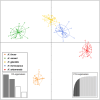Mining expressed sequence tag (EST) microsatellite markers to assess the genetic differentiation of five Hynobius species endemic to Taiwan
- PMID: 39245775
- PMCID: PMC11381558
- DOI: 10.1038/s41598-024-71887-1
Mining expressed sequence tag (EST) microsatellite markers to assess the genetic differentiation of five Hynobius species endemic to Taiwan
Abstract
Taiwan harbors five endemic species of salamanders (Hynobius spp.) that inhabit distinct alpine regions, contributing to population fragmentation across isolated "sky islands". With an evolutionary history spanning multiple glacial-interglacial cycles, these species represent an exceptional paradigm for exploring biogeography and speciation. However, a lack of suitable genetic markers applicable across species has limited research efforts. Thus, developing cross-amplifying markers is imperative. Expressed sequence-tag simple-sequence repeats (EST-SSRs) that amplify across divergent lineages are ideal for species identification in instances where phenotypic differentiation is challenging. Here, we report a suite of cross-amplifying EST-SSRs from the transcriptomes of the five Hynobius species that exhibit an interspecies transferability rate of 67.67%. To identify individual markers exhibiting cross-species polymorphism and to assess interspecies genetic diversity, we assayed 140 individuals from the five species across 84 sampling sites. A set of EST-SSRs with a high interspecies polymorphic information content (PIC = 0.63) effectively classified these individuals into five distinct clusters, as supported by discriminant analysis of principal components (DAPC), STRUCTURE assignment tests, and Neighbor-joining trees. Moreover, pair-wise FST values > 0.15 indicate notable between-cluster genetic divergence. Our set of 20 polymorphic EST-SSRs is suitable for assessing population structure within and among Hynobius species, as well as for long-term monitoring of their genetic composition.
Keywords: Hynobius; EST-SSRs; Microsatellite; Taiwanese salamander; Transcriptome.
© 2024. The Author(s).
Conflict of interest statement
The authors declare no competing interests.
Figures





Similar articles
-
Development of EST-SSR markers in Cenchrus ciliaris and their applicability in studying the genetic diversity and cross-species transferability.J Genet. 2019 Nov;98:101. J Genet. 2019. PMID: 31767818
-
Development of novel EST-SSR markers in the macaúba palm (Acrocomia aculeata) using transcriptome sequencing and cross-species transferability in Arecaceae species.BMC Plant Biol. 2018 Nov 12;18(1):276. doi: 10.1186/s12870-018-1509-9. BMC Plant Biol. 2018. PMID: 30419831 Free PMC article.
-
Assessing Genetic Diversity in Endangered Plant Orchidantha chinensis: Chloroplast Genome Assembly and Simple Sequence Repeat Marker-Based Evaluation.Int J Mol Sci. 2024 Oct 17;25(20):11137. doi: 10.3390/ijms252011137. Int J Mol Sci. 2024. PMID: 39456923 Free PMC article.
-
Development of EST-SSR markers for genetic diversity analysis in coconut (Cocos nucifera L.).Mol Biol Rep. 2020 Dec;47(12):9385-9397. doi: 10.1007/s11033-020-05981-8. Epub 2020 Nov 19. Mol Biol Rep. 2020. PMID: 33215363
-
Genic microsatellite markers in plants: features and applications.Trends Biotechnol. 2005 Jan;23(1):48-55. doi: 10.1016/j.tibtech.2004.11.005. Trends Biotechnol. 2005. PMID: 15629858 Review.
Cited by
-
The Application of Microsatellite Markers as Molecular Tools for Studying Genomic Variability in Vertebrate Populations.Curr Issues Mol Biol. 2025 Jun 11;47(6):447. doi: 10.3390/cimb47060447. Curr Issues Mol Biol. 2025. PMID: 40699846 Free PMC article. Review.
-
Karyotype of Hynobiusfucus Lai et Lue, 2008, a salamander endemic to Taiwan with comments in memory of June-Shian Lai, a pioneer in studies of mountainous salamanders (Urodela, Hynobiidae).Comp Cytogenet. 2025 Aug 14;19:155-165. doi: 10.3897/compcytogen.19.158987. eCollection 2025. Comp Cytogenet. 2025. PMID: 40862021 Free PMC article.
References
-
- Lai, J. S. & Lue, K. Y. Two new (Caudata: Hynobiidae) salamanders from Taiwan. Herpetologica64, 63–80. 10.1655/06-065.1 (2008). 10.1655/06-065.1 - DOI
-
- IUCN. The IUCN Red List of Threatened Species. https://www.iucnredlist.org (2021).
MeSH terms
LinkOut - more resources
Full Text Sources
Research Materials
Miscellaneous

